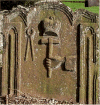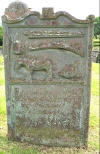|
Trade
memorials and gravestones.
Throughout
the 17th century there was increasing competition between
the burgh merchants and the trade guilds. The merchants
for a long time held the positions of authority and power,
in part due to the fact that they also had money to spend
and lend. The merchants of the City of London were for a
long time the main source of funding for the King.
Superiority, or snobbery if you like, appeared in the
graveyard with the quality and size of memorials and
family graves. The Guilds, however, gradually took pride
of place as the 17th century edged towards the industrial
revolution with innovations in production and increasing
consumer demand. This was reflected in the emblems that
appeared in their gravestones as a certain pride in one`s
status emerged.
Some of the
symbols of certain trades are much older and more common
such as the smith – whether the blacksmith who worked iron
or the tinsmith, the silver and copper smiths. These came
together under the signs of the `Hammermen` and
included workers of
 almost almost
any kind who applied a hammer in the course of production,
Thus it also included the armourers, goldsmiths, pewter
workers, glovers, saddlers, and even girdlemakers. Some of
the specialist groups later formed their own guilds or
society. The general symbol was the crown above a hammer,
but also the anvil, pincers, rasps, horshoes, bellows and
wire drawing tools for making nails used by the metal
smiths / blacksmiths.
Another
long standing symbol was that of the miller who used
sheaves of corn, scales, millstones and brushes. The
commonest was the piece of the machinery called the `rind`
which supported the upper millstone – the image of crossed
rinds was called the `mouline` The associated trade of the
bakers used the tool called a peel, a long handled kind of
flat shovel used to put dough into the oven and for
lifting out the baked bread; they also used a tool called
the scuffle – another long handled tool with cloth wrapped
round the end for cleaning out the ovens. More prosaically
there was the rolling pin.
No town or
village worth the name was without a
Maltman who prepared the barley (called bear) used in
brewing beer. They too used long handled shovels,
including the slatted version called the mash oar,
for stirring the hot mash. They also used tongs for
handling peat and specialist tools – the firehook or
weedock used when stoking the fire. With this group were
the brewers who used the barrel of ale and also the
`garbe` a sheaf of corn. The barrel makers or
coopers, used the symbol of the dividers ( to measure and
circumscribe arcs and circles ) and their hammer used to
drive the metal bands round the staves and hold the barrel
together. The coopers would not have known the modern,
official description of the barrel – “the middle frustrum
of a prolate spheroid”.
Farmers,
mostly tenants ( feu holders would be wealthy enough for a
more prestigious memorial) used a range of symbols
which were largely self evident to the people in the
farming community but probably
unrecognised by a modern town dweller. These were the
`sock` ( which held the coulter in place) and `coulter`
(the blade that cuts into and turns the soil) – the metal
parts of old ploughs. They also used farming
equipment – the swingle trees ( the pivoted cross bar to
which horse or oxen traces were fastened) , the infamous
flail ( a favoured weapon of the Galloway Covenanters)
and the caschrom – the foot plough that gave a single
shallow furrow. Also yokes, harrows and quite rarely,
butter churns and cheese presses.
Other old
trades were the wrights- woodwrights, shipwrights,
wheelwrights etc who used the hammer, axe, saw, dividers
and set square. The masons and stoneworkers used the
symbol of the three castles, the trowel, dividers,
wedges, the set square, the level and the mell or mallet.
The slaters used their hammer (rather like a mountaineers
pick in shape) and their special draw knife with its T
shape but with a curved blade and sharp pointed ends.
A trade of
long standing were the weavers or `wobsters` whose symbols
were mainly the frame, reed and shuttle of the loom,
and the tenterhooks or stretchers shaped like a claw. The
other main trade in cloth working was the waulkmiller, who
cleaned and fulled ( thickened the cloth by beating and
washing) the wobster`s production or warp – they used as
symbols very large shears and the fulling pot ( an urn
shaped container holding water). The tailor was often the
winter job of the cottar whose family may also have been
weavers. The tailor`s emblems were the `goose` – a
pressing iron with a rounded handle, the pressing
iron with a straight handle, shears, bobbins and a
pressing board (the modern day ironing board).
Other
trades used symbols of their speciality – the cordiners or
shoemakers had the sole cutter, nippers, awl and
their special knife – a large curved blade with handle in
the middle, used to cut leather with a `rocking` action.
 The The
fleshers or butchers had their axe, cleavers and
sharpening steel. The fishermen had their boats, nets,
oars and fish with sometimes an inscription of “Lax
fisher” meaning a salmon fisher. The gardeners had their
spade, a rake, a pruning ( or sneading) knife and
vegetable produce. Shepherds had their crook sheep and
dogs; fowlers their guns, traps and powder flask;
gamekeepers guns, powder flasks, fishing rods , dogs
and birds. A famous stone in this respect is that of John
Murray of Kells, a well known character of his day.
Return to Old Mortality.
|